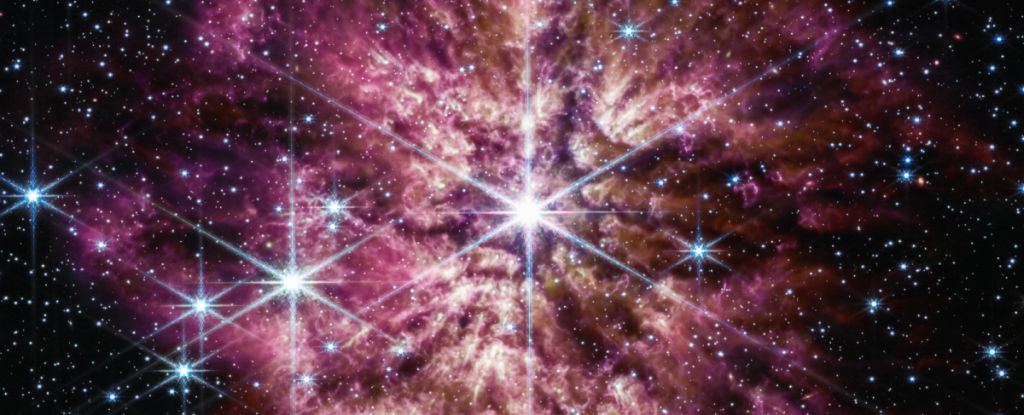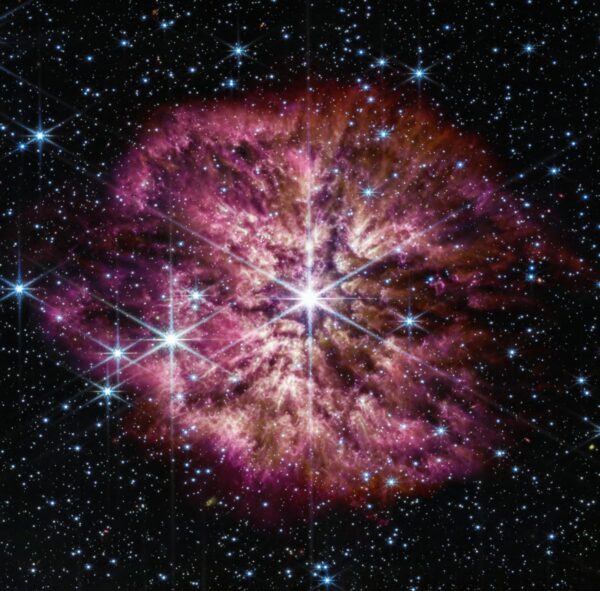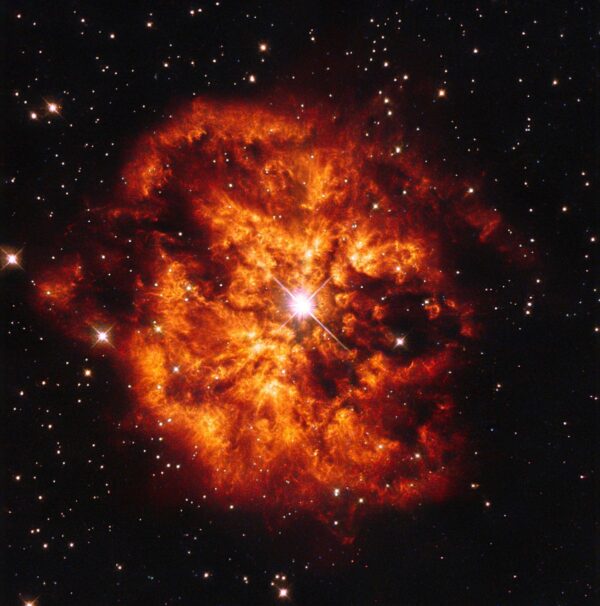
Posted on 03/16/2023 9:04:32 AM PDT by Red Badger

JWST's new image of WR 124 and its nebula. (NASA, ESA, CSA, STScI, Webb ERO Production Team)
There's scintillating beauty to be found in cosmic death.
In a new image from the JWST, the spectacular final throes of a star nearing the end of its life are revealed in all their intricate detail.
Located in the constellation Sagittarius, the star WR 124 is what's known as a Wolf-Rayet, which are rarely seen in the Milky Way. That's because only certain stars turn into Wolf-Rayets, and even then their time in that phase is so short; in just a few hundred thousand years, WR 124 is going to explode in a glorious supernova.
Wolf-Rayet stars can be some of the most spectacular stars in the galaxy. They are very hot, very bright, blazing away in a last scream of light at the end of their main-sequence lifespan as their fusion fuel runs low.

The full new image of WR 124. (NASA, ESA, CSA, STScI, Webb ERO Production Team)
At this point, they are significantly depleted in hydrogen, but rich in nitrogen or carbon. They are also losing mass at a very high rate. The mass they lose is also high in carbon, which absorbs radiation and re-emits it as infrared light. This makes them a very attractive target for the JWST, which is not only the most powerful space telescope ever built, but produces the highest resolution infrared and near-infrared images.
WR 124 is a Wolf-Rayet star that has already lost quite a bit of mass; it's surrounded by an elaborate cloud of its own ejected material, scored by filaments and knots as it expands out into the space around the star, glowing in infrared light as it cools. We know from previous observations that that cloud is a fascinating and complex tangle, but so far have lacked enough high-resolution detail to understand the subtleties.
For example, when WR 124 does eventually explode, are the grains of dust in its nebula large enough to survive the supernova? Learning this could give astronomers some important insight into the contribution Wolf-Rayet stars make to the interstellar dust budget – material that then becomes incorporated into other stars and planets as they form.
 An image of WR 124 taken using the Hubble Space Telescope and released in 2015. (ESA/Hubble/NASA/Judy Schmidt)
An image of WR 124 taken using the Hubble Space Telescope and released in 2015. (ESA/Hubble/NASA/Judy Schmidt)
It could also help identify the supernova remnants left behind by Wolf-Rayet stars, which in turn could let us know how they explode. Astronomers think Wolf-Rayet stars are the progenitors of Type Ib and Type Ic supernovae, but definitive evidence is scant; understanding the dust emitted by the star prior to death could help link the stars to the clouds of debris they leave behind.
Interestingly, WR 124 belongs to a mysterious category of Wolf-Rayet stars that are careering through space at tremendous velocities relative to the rotational speed of the galactic disk itself. WR 124 is one of the fastest runaway stars in the Milky Way, with a speed of 190 kilometers (118 miles) per second.
It's not known why it's zooming through space so fast, but recent research suggested that it was in a binary system with another dying star, whose own supernova punted WR 124 out of its position in the galactic disk.
The JWST data may or may not help figure out this mystery; it doesn't appear to be a huge priority. We just think it's really neat.
You can download a high-resolution version of the new image from the NASA website.
https://www.nasa.gov/feature/goddard/2023/nasa-s-webb-telescope-captures-rarely-seen-prelude-to-supernova
Ping!...................
Real estate values go down when a WR star moves into your neighborhood.
I like the Hubble image better. It may not be as sharp and the colors are different but it get the point across better. It looks like a star ready to explode.
What happens to material ALREADY denser than Iron that gets absorbed during the formation of a new star?
They become Democrats and run for Governor of Georgia twice and lose twice...........
Uuummmm. I thought this same picture was boasting a radical super massive star swallowing up all neighborhood galaxies just a few threads ago??
“in just a few hundred thousand years, WR 124 is going to explode in a glorious supernova.”
I’m over seventy so I don’t need to set my alarm clock?
Thats us. Genesis 15:5
Nothing to see here move along!...
According to Wikipedia, WR 124 (also known as QR Sagittae) is 21,000 light-years away (give or take a couple of thousand years). So it could have already exploded.
The bright star in the middle has nothing to do with the nebula but is just in the line of sight and therefore superimposed. But it looks cool.
I don’t know that JWST “caught sight” of anything but the headline caught me. I feel duped, give or take a few hundred thousand years.
15,000 light-years away, located in the constellation Sagittarius
https://hubblesite.org/contents/media/images/1998/38/727-Image.html?news=true
Disclaimer: Opinions posted on Free Republic are those of the individual posters and do not necessarily represent the opinion of Free Republic or its management. All materials posted herein are protected by copyright law and the exemption for fair use of copyrighted works.